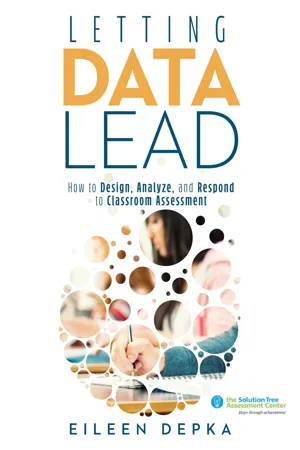
Letting Data Lead
How to Design, Analyze, and Respond to Classroom Assessment (Gain Actionable Insights Through Effective Assessment Methods and Data Interpretation)
- 160 pages
- English
- ePUB (mobile friendly)
- Available on iOS & Android
Letting Data Lead
How to Design, Analyze, and Respond to Classroom Assessment (Gain Actionable Insights Through Effective Assessment Methods and Data Interpretation)
About This Book
Rely on Letting Data Lead by Eileen Depka to help you build a culture of school data analysis and interpretation, data-driven instruction and assessment techniques, and student achievement. This practical resource clearly outlines a systematic approach for meaningful student data collection through quality classroom assessment methods. The included assessment techniques, tools, templates, and specific examples are designed to empower educators to turn gathered information into immediate, thoughtful action.
Develop data-collection and analysis methods for effectively tracking student progress and fostering student success:
- Obtain templates and methods for collecting, interpreting, and responding to assessment data.
- Define the purpose of assessments to distinguish between when a response is needed and when a response is not essential.
- Design classroom assessment for student learning in a way that creates actionable insights and pinpoints where students are struggling.
- Consider practices that support the systematic approach to responding to student results with data-driven instruction.
- Build a classroom culture where students react to their personal data, set goals, and engage in critical thinking.
Contents:
Introduction
Chapter 1: Designing Assessments -- Where Data Response Starts
Chapter 2: Creating a Structure to Support Data Consistency for Common Assessments
Chapter 3: Visualizing and Interpreting Data With an Eye on Action
Chapter 4: Responding to Data -- Considerations, Practices, and Procedures
Chapter 5: Encouraging Students to Respond to Data
Chapter 6: Considering Sustainability
Epilogue: Closing Thoughts
Frequently asked questions
Information
Table of contents
- Cover
- Title Page
- Copyright
- Acknowledgments
- Table of Contents
- About the Author
- Introduction
- Chapter 1: Designing Assessments: Where Data Response Starts
- Chapter 2: Creating a Structure to Support Data Consistency for Common Assessments
- Chapter 3: Visualizing and Interpreting Data With an Eye on Action
- Chapter 4: Responding to Data: Considerations, Practices, and Procedures
- Chapter 5: Encouraging Students to Respond to Data
- Chapter 6: Considering Sustainability
- Epilogue: Closing Thoughts
- References and Resources
- Index